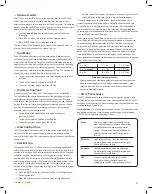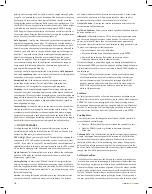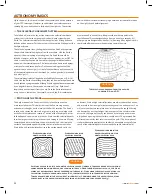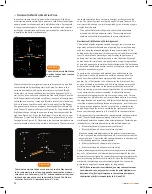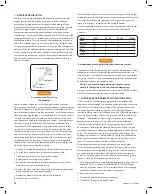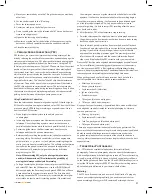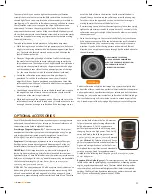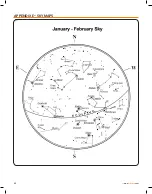
26
>>
www
.celestron
.com
>>
Eyepiece Projection
This form of celestial photography is designed for objects with small
angular sizes, primarily the Moon and planets . Planets, although
physically quite large, appear small in angular size because of their
great distances. Moderate to high magnification is, therefore, required
to make the image large enough to see any detail . Unfortunately,
the camera/telescope combination alone does not provide enough
magnification to produce a usable image size on film. In order to get the
image large enough, you must attach your camera to the telescope with
the eyepiece in place. To do so, you need two additional accessories; a
deluxe tele-extender (#93643), which attaches to the visual back and a
T-ring for your particular camera make (i .e ., Minolta, Nikon, Pentax, etc .) .
Because of the high magnifications during eyepiece projection, the field
of view is quite small which makes it difficult to find and center objects.
To make the job a little easier, align the finder as accurately as possible.
This allows you to get the object in the telescope’s field based on the
finder’s view alone.
FIGURE 8-3
Accessories for Projection
Photography
Another problem introduced by the high magnification is vibration.
Simply tripping the shutter – even with a cable release – produces enough
vibration to smear the image . To get around this, use the camera’s self-
timer if the exposure time is less than one second – a common occurrence
when photographing the Moon. For exposures over one second, use the
“hat trick .” This technique incorporates a hand-held black card placed
over the aperture of the telescope to act as a shutter . The card prevents
light from entering the telescope while the shutter is released. Once
the shutter has been released and the vibration has diminished (a few
seconds), move the black card out of the way to expose the film. After
the exposure is complete, place the card over the front of the telescope
and close the shutter. Advance the film and you’re ready for your next
shot. Keep in mind that the card should be held a few inches in front of
the telescope, and not touching it. It is easier if you use two people for
this process; one to release the camera shutter and one to hold the card.
Here’s the process for making the exposure .
1. Find and center the desired target in the viewfinder of your camera.
2 . Turn the focus knob until the image is as sharp as possible .
3 . Place the black card over the front of the telescope .
4 . Release the shutter using a cable release .
5 . Wait for the vibration caused by releasing the shutter to diminish .
Also, wait for a moment of good seeing .
6. Remove the black card from in front of the telescope for the duration
of the exposure (see accompanying table) .
7. Replace the black card over the front of the telescope.
8 . Close the camera’s shutter .
Advance the film and you are ready for your next exposure. Don’t forget
to take photos of varying duration and keep accurate records of what you
have done . Record the date, telescope, exposure duration, eyepiece,
f/ratio, film and some comments on the seeing conditions.
The following table lists exposures for eyepiece projection with a 10 mm
eyepiece . All exposure times are listed in seconds or fractions of
a second .
FIGURE 8-4
Recommended exposure time for photographing planets.
Planet
ISO 50
ISO 100
ISO 200
ISO 400
Moon
4 2 1
1/2
Mercury 16
8
4
2
Venus 1/2 1/4 1/8
1/15
Mars 16 8 4
2
Jupiter
8 4 2
1
Saturn 16 8
4
2
The exposure times listed here should be used as a starting point . Always
make exposures that are longer and shorter than the recommended
time . Also, take a few photos at each shutter speed . This will ensure that
you get a good photo. It is not uncommon to go through an entire roll of
36 exposures and have only one good shot.
NOTE: Don’t expect to record more detail than you can see
visually in the eyepiece at the time you are photographing.
Once you have mastered the technique, experiment with different films,
different focal length eyepieces and even different filters.
>>
Long Exposure Prime Focus Photography
This is the last form of celestial photography to be attempted after
others have been mastered. It is intended primarily for deep sky objects
that are objects outside our solar system which includes star clusters,
nebulae and galaxies. While it may seem that high magnification is
required for these objects, just the opposite is true. Most of these objects
cover large angular areas and fit nicely into the prime focus field of your
telescope. The brightness of these objects, however, requires long
exposure times and, as a result, are rather difficult to photograph.
There are several techniques for this type of photography, and the
one chosen will determine the standard accessories needed . The best
method for long exposure deep sky astrophotography is with an off-axis
guider . This device allows you to photograph and guide through the
telescope simultaneously. Celestron offers a very special and advanced
off-axis guider, called the Radial Guider (#94176). In addition, you will
need a T-Ring to attach your camera to the Radial Guider .
Other equipment needs include a guiding eyepiece. Unlike other
forms of astrophotography which allows for fairly loose guiding, prime
focus requires meticulous guiding for long periods . To accomplish this
you need a guiding ocular with an illuminated reticle to monitor your
guide star. For this purpose, Celestron offers the Micro Guide Eyepiece
(#94171). Here is a brief summary of the technique.
1 . Polar align the telescope using an optional equatorial wedge . To polar
align the CPC you must select EQ North Align (or EO South Align)
from the alignment options. For more information on polar aligning,
see the Polar Alignment section earlier in the manual .
2 . Remove all visual accessories .
3 . Thread the Radial Guider onto your telescope .
4 . Thread the T-Ring onto the Radial Guider .
T-Ring
Tele-Extender
Eyepiece
Visual Back
35 mm SLR
Содержание 11007
Страница 1: ...InstructionManual 11007 11008 11009...
Страница 2: ...www celestron com...
Страница 40: ...38 www celestron com APPENDIXD MAPSOFTIMEZONES...
Страница 41: ...www celestron com 39...
Страница 42: ...40 www celestron com APPENDIXE SKYMAPS...
Страница 43: ...www celestron com 41...
Страница 44: ...42 www celestron com...
Страница 45: ...www celestron com 43...
Страница 46: ...44 www celestron com...
Страница 47: ...www celestron com 45...


